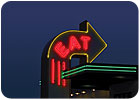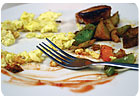
Our fluctuating, mobile economy has forced many contractors today to travel further afield in search of work in regions of the country where building permits are on the rise. In light of this trend toward increased travel, I believe a discussion of the dangers of food eaten while on the road won't seem all that unrelated to occupational safety and health.
Not long ago I received a call from a residential contractor I've known for years. He'd taken his crew down to the Gulf States to work in the "war zone," as he graphically described it. He called because he was bored, as he and most of his crew were temporarily "out of service" with food poisoning. I knew what he was going through. As a young man hauling hay cross-country, I stopped after midnight at an Indianapolis truck stop for a meal. I ordered what turned out to be yesterday's special, creamed chicken and rice. Just before sunrise, in another state, I pulled into a rest area to grab a steering-wheel nap. I awoke days later in a skimpy hospital gown, witless and wondering who had stolen my pants. I was sicker than I had ever been before in my life. I was informed by the intern that, despite all the messages my body was broadcasting, I would actually survive. It seemed that a sharp-eyed daily route driver had seen my truck idling in the rest area for 24 straight hours, and called the highway patrol to investigate. I spent the next 10 days flat on my back and weak as a fish. Upon discharge, I tried to get back behind the wheel to finish my delivery and suffered an immediate relapse. That week was worse than the week before by a factor of 50. Feeling not so much a tough guy as a fool, I found myself on a plane headed back East, with another driver finishing my trip. It was months before I could actually keep my feet underneath me for more than a few hours.

Food-Borne Illness
I was diagnosed with botulism, resulting from ingesting the powerful paralytic toxins ofClostridium botulinum, most likely from improperly handled, cooked or preserved poultry. Botulism occurs when the anaerobic bacteria grow in improperly preserved foods with a low acid content. There are many other types of food poisoning agents out there waiting patiently on our porcelain. Microscopic culprits exist such as staph aureus, E. coli, salmonella, shigella and listeria, just to mention a few. As a generic group of diseases, food poisoning typically proves most fatal to the very young and the elderly. Victims with other serious medical conditions (such as kidney disease, diabetes, HIV and cancer) are also at higher risk of succumbing to this disease.Worldwide, food poisoning affects almost 80 million people, resulting in 6 milion to 8 million deaths yearly. According to the World Health Organization (WHO), every year in the United States 76 million cases of food-borne illnesses are recorded, or 26,000 victims per 100,000 inhabitants. This is significantly higher percentage than in England (3,400 per 100,000) or France (1,210 per 100,000), and many experts suspect a great number of cases go unreported. Food poisoning tends to affect whole groups of diners wherever food may be undercooked, left unrefrigerated too long or handled and prepared using poor personal hygiene practices.
Symptoms and Causes
Most types of food poisoning show physiological signs of onset within hours of eating. Symptoms may include the onset of an unusually vile case of bad breath, nausea and/or vomiting, very severe abdominal cramps, diarrhea, overall weakness and even paralysis. A severe symptom of the disease may be blood in the stool, but dehydration can prove to be the most dangerous symptom, and it can cause renal damage in the long run if not treated.In some cases, severe headaches, fevers and chills come and go repeatedly, or all the symptoms may occur simultaneously, making for a very bad day. Other serious symptoms include respiratory distress, irregular or fast heartbeat, double vision, and difficulty speaking or swallowing. Doctors tell me once you've been overcome once by food poisoning, you are more susceptible to the illness in the future.
Apart from the direct bacterial infection, some food-borne illnesses are caused by the exotoxins produced as the bacteria grow. In the case of botulism, these toxins can remain effective long after the bacteria that produce them are no longer viable.
Bacteria aren't the only microscopic agents to fear. Viral infections make up about 33 percent of all food-borne illnesses. Methods of infection include human-to-food-to-human transmissions. Common food-carried viruses include norovirus, rotavirus, and hepititus A and E. In warmer climates, many food-borne parasites (zoonoses) may also be the cause of gastrointestinal diseases. These include platyhelminthes, nematodes (tapeworms and flatworms) and protozoans (cyclospora, cryptosporidium, giardia). In rare cases, food-borne illnesses may be caused by pesticides, herbicides or even livestock medicines found in the food chain.

Seeking Treatment
This article is not intended to give any professional medical advice or guidance to anyone stricken by food poisoning. This is a serious condition requiring urgent professional care. If you become ill on the road, you should always immediately seek the medical care and advice available 24/7 at the nearest emergency medical center. The directions to the nearest hospital can be easily picked up from miles away on most major highways by the rectangular blue road signs displaying the reflective white letter "H." Every directional change should be clearly marked by a similar sign with a reflective arrow until the emergency entrance is clearly in view. A healthy individual can recover from mild to moderate cases of most common food poisoning within several days with proper treatment and bed rest. This treatment involves analgesics for pain and intravenous fluids for dehydration symptoms. Medical observation is required to determine if any organs have been adversely affected. If you suspect that you have conducted a case of food poisoning, get yourself medical treatment immediately and have the physician make the diagnosis and determine the best course of treatment.Prevention
Careful hand washing, conscientious personal hygiene while handling food, proper waste disposal methods, and techniques designed to thoroughly clean and maintain dishes and cooking utensils in uncontaminated condition are some of the best ways to prevent the transmission of toxic substances or disease organisms which may occasionally appear anywhere around food. Placing cooked meat or fish on a surface contaminated by uncooked meat may easily cross-contaminate the meal. Refrigerator temperatures should remain several degrees below 40°F, while freezers must remain below zero. Power outages are always a concern, and opening refrigerators and freezers to check on the contents quickly raises the interior temperatures. Meat and fish should be fresh whenever possible or practical, but after delivery by a wholesaler, meat and fish should not be refrigerated more than two days before use, as their storage time and conditions are always unknown. E.coli bacteria may easily enter the food chain through the water source as you clean or rinse foods. While cooking foods for 20 minutes at 160° will kill almost all harmful bacteria, salmonella is even more insidious, as it can survive almost any inhospitable environment (temperature, pH, radiation) by forming a cyst around each cell. Salmonella can reculture years later from a quantity as small as 15 to 20 cells. As some food-borne illnesses (such as giardia, cryptosporidium, shigella, and hepatitis A) are transmitted to food via a water vector, have your well and tap water checked regularly to detect these contaminants early.When Dining Out
On the road, look for hot, freshly cooked and prepared foods from dependable sources served by clean wait staff. When dining alone, I prefer to sit at a restaurant counter rather than at a table. That way, I can take an occasional glance into the kitchen and look for disposable laytex/vinyl gloves on food handlers, hairnets, as well as general health and hygiene of the staff. Also a quick look at the floor area behind the counter and wait staff workstations may indicate the overall cleanliness and sanitation of the establishment.If you were to walk around the counter and look at the side not visible to the customers, you might be amazed at what you see or don't see. This view can prove disturbing, particularly if that is from where your silverware appears. Avoid eating and drinking in establishments wherever plates, glasses and silverware may be washed at a undercounter wash sink. The boosted wash/rinse water temperatures (above 180°) common with many commercial dishwashers are required to maintain sanitary eating surfaces, despite other methods of disinfection (chlorine). These units are typically large enough to accommodate wash racks and produce large clouds of steam, making them inconvenient at the counter. Mouse and rat baits, ant cups, flypaper, as well as all non-USDA-approved cleaning products (lye, bleach, etc.) should never be observable anywhere near and eating or serving areas.
Physical clues are always available if you're observant. How long does a waiter spend in the bathroom? If he's in and out in less than a minute, then hand washing was probably not conducted thoroughly.
Prevention Tips
It is estimated that almost half of the food poisoning cases and most of the common cold and flu transmission in this country could be eliminated with proper hand-washing techniques, which include:- Wash hands in warm, soapy water before preparing food.
- Wash after handling raw meat, poultry and seafood.
- Wash front and back up to your wrists, between fingers and under fingernails.
- Wash hands after finishing one task, before starting another.
- Dry hands on disposable towels (cloth towels can be used if they are laundered after each use).
- Wash long enough to sing "Happy Birthday" or "The Alphabet Song" twice (at least 45 seconds).
- Wash sponges and towels in bleach. Replace often.
Food service personnel should be trained to handle food safely, and personnel should follow these procedures:
- Whenever possible, avoid touching nose, mouth and hair. When you must touch your nose, mouth or hair, immediately wash hands after doing so.
- Clean and maintain uniforms. Use aprons. Do not wipe hands on uniforms.
- Coughing and sneezing may spread contamination as far as 30 feet. Use disposable tissues when sneezing or coughing and wash hands immediately.
Food preparers have some standard safety procedures as well:
- Always use two cutting boards and two knives - one set for meats and fish, the other for breads and vegetables.
- Wash cutting boards in hot, soapy water or in a dishwasher. Discard boards with cracks, crevices and excessive knife scars.
- Wash plates between uses or use separate plates.
- Store raw meat on the refrigerator's bottom shelf and in proper containers so juices do not drip on food below.
- Use one utensil to taste, another to stir/mix/serve.
- Always insert the thermometer in the thickest area of meat/poultry/fish and wash it thoroughly after each use
- Cook meat (beef/pork) to medium (160°) or well-done(170°).
- Cook whole chicken/turkey to 180° (ground to 165°).
- Cook egg dishes to 160°.
- Cook all leftovers to 165°.
- Once served, never return meat, fish, poultry to a stock pot.
- Use cleaned scissors or knives to open bags and other containers.
- Wear latex (or nitrile) gloves if you have a sore or cut on your hand (not just a bandage).
Parting Advice
When I became poisoned by food in one state and symptomatic in another state, I realized there was little legal recourse available to have the alleged dining establishment inspected or charge with a violation. Health department codes are statewide only and jurisdiction and enforcement is impotent across state lines. Now I try to avoid eating just before crossing a state line. I'll stop at the next exit instead. The physician who treated and discharged me suggested that people like myself, who are constantly traveling and who do not frequent the same local, dependable restaurants, should refrain from eating poultry or fish dishes. He told me that chicken and fish can be treated with sauces and spices to mask their odor as they begin to spoil, but spoiled beef willnevermake it past your nose. It is advice I still value today.The most dependable advice I can offer workers when they are dining while on the road is to always be aware of your own instincts. If something doesn't look or feel right when you stop at a roadside tavern, then it probably isn't. Experienced travelers know it's best to pay and leave their order uneaten whenever they have doubts. Once you're back on the road, grab some fresh, washed fruit and bottled water to quell you hunger and look for another establishment. It will always take less time and money than getting serious ill.

Report Abusive Comment